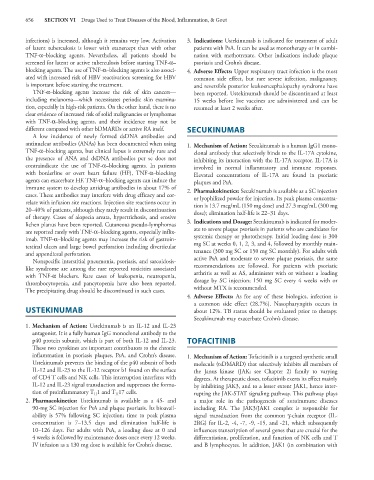Page 670 - Basic _ Clinical Pharmacology ( PDFDrive )
P. 670
656 SECTION VI Drugs Used to Treat Diseases of the Blood, Inflammation, & Gout
infections) is increased, although it remains very low. Activation 3. Indications: Ustekinumab is indicated for treatment of adult
of latent tuberculosis is lower with etanercept than with other patients with PsA. It can be used as monotherapy or in combi-
TNF-α–blocking agents. Nevertheless, all patients should be nation with methotrexate. Other indications include plaque
screened for latent or active tuberculosis before starting TNF-α– psoriasis and Crohn’s disease.
blocking agents. The use of TNF-α–blocking agents is also associ- 4. Adverse Effects: Upper respiratory tract infection is the most
ated with increased risk of HBV reactivation; screening for HBV common side effect, but rare severe infection, malignancy,
is important before starting the treatment. and reversible posterior leukoencephalopathy syndrome have
TNF-α–blocking agents increase the risk of skin cancers— been reported. Ustekinumab should be discontinued at least
including melanoma—which necessitates periodic skin examina- 15 weeks before live vaccines are administered and can be
tion, especially in high-risk patients. On the other hand, there is no resumed at least 2 weeks after.
clear evidence of increased risk of solid malignancies or lymphomas
with TNF-α–blocking agents, and their incidence may not be
different compared with other bDMARDs or active RA itself. SECUKINUMAB
A low incidence of newly formed dsDNA antibodies and
antinuclear antibodies (ANAs) has been documented when using 1. Mechanism of Action: Secukinumab is a human IgG1 mono-
TNF-α–blocking agents, but clinical lupus is extremely rare and clonal antibody that selectively binds to the IL-17A cytokine,
the presence of ANA and dsDNA antibodies per se does not inhibiting its interaction with the IL-17A receptor. IL-17A is
contraindicate the use of TNF-α–blocking agents. In patients involved in normal inflammatory and immune responses.
with borderline or overt heart failure (HF), TNF-α–blocking Elevated concentrations of IL-17A are found in psoriatic
agents can exacerbate HF. TNF-α–blocking agents can induce the plaques and PsA.
immune system to develop antidrug antibodies in about 17% of 2. Pharmakokinetics: Secukinumab is available as a SC injection
cases. These antibodies may interfere with drug efficacy and cor- or lyophilized powder for injection. Its peak plasma concentra-
relate with infusion site reactions. Injection site reactions occur in tion is 13.7 mcg/mL (150 mg dose) and 27.3 mcg/mL (300 mg
20–40% of patients, although they rarely result in discontinuation dose); elimination half-life is 22–31 days.
of therapy. Cases of alopecia areata, hypertrichosis, and erosive
lichen planus have been reported. Cutaneous pseudo-lymphomas 3. Indications and Dosage: Secukinumab is indicated for moder-
are reported rarely with TNF-α–blocking agents, especially inflix- ate to severe plaque psoriasis in patients who are candidates for
imab. TNF-α–blocking agents may increase the risk of gastroin- systemic therapy or phototherapy. Initial loading dose is 300
testinal ulcers and large bowel perforation including diverticular mg SC at weeks 0, 1, 2, 3, and 4, followed by monthly main-
and appendiceal perforation. tenance (300 mg SC or 150 mg SC monthly). For adults with
Nonspecific interstitial pneumonia, psoriasis, and sarcoidosis- active PsA and moderate to severe plaque psoriasis, the same
like syndrome are among the rare reported toxicities associated recommendations are followed. For patients with psoriatic
with TNF-α blockers. Rare cases of leukopenia, neutropenia, arthritis as well as AS, administer with or without a loading
thrombocytopenia, and pancytopenia have also been reported. dosage by SC injection; 150 mg SC every 4 weeks with or
The precipitating drug should be discontinued in such cases. without MTX is recommended.
4. Adverse Effects: As for any of these biologics, infection is
a common side effect (28.7%). Nasopharyngitis occurs in
USTEKINUMAB about 12%. TB status should be evaluated prior to therapy.
Secukinumab may exacerbate Crohn’s disease.
1. Mechanism of Action: Ustekinumab is an IL-12 and IL-23
antagonist. It is a fully human IgG monoclonal antibody to the
p40 protein subunit, which is part of both IL-12 and IL-23. TOFACITINIB
These two cytokines are important contributors to the chronic
inflammation in psoriasis plaques, PsA, and Crohn’s disease. 1. Mechanism of Action: Tofacitinib is a targeted synthetic small
Ustekinumab prevents the binding of the p40 subunit of both molecule (tsDMARD) that selectively inhibits all members of
IL-12 and IL-23 to the IL-12 receptor b1 found on the surface the Janus kinase (JAK; see Chapter 2) family to varying
of CD4 T cells and NK cells. This interruption interferes with degrees. At therapeutic doses, tofacitinib exerts its effect mainly
IL-12 and IL-23 signal transduction and suppresses the forma- by inhibiting JAK3, and to a lesser extent JAK1, hence inter-
tion of proinflammatory T 1 and T 17 cells. rupting the JAK-STAT signaling pathway. This pathway plays
H
H
2. Pharmacokinetics: Ustekinumab is available as a 45- and a major role in the pathogenesis of autoimmune diseases
90-mg SC injection for PsA and plaque psoriasis. Its bioavail- including RA. The JAK3/JAK1 complex is responsible for
ability is 57% following SC injection; time to peak plasma signal transduction from the common γ-chain receptor (IL-
concentration is 7–13.5 days and elimination half-life is 2RG) for IL-2, -4, -7, -9, -15, and -21, which subsequently
10–126 days. For adults with PsA, a loading dose at 0 and influences transcription of several genes that are crucial for the
4 weeks is followed by maintenance doses once every 12 weeks. differentiation, proliferation, and function of NK cells and T
IV infusion as a 130 mg dose is available for Crohn’s disease. and B lymphocytes. In addition, JAK1 (in combination with

